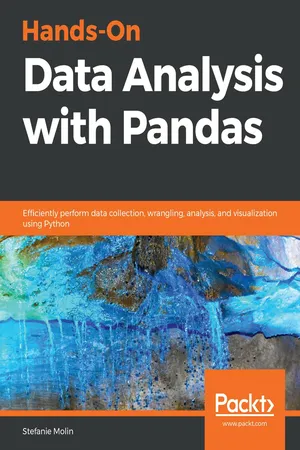
Hands-On Data Analysis with Pandas
Efficiently perform data collection, wrangling, analysis, and visualization using Python
- 716 pages
- English
- ePUB (mobile friendly)
- Available on iOS & Android
Hands-On Data Analysis with Pandas
Efficiently perform data collection, wrangling, analysis, and visualization using Python
About this book
Get to grips with pandas—a versatile and high-performance Python library for data manipulation, analysis, and discovery
Key Features
- Perform efficient data analysis and manipulation tasks using pandas
- Apply pandas to different real-world domains using step-by-step demonstrations
- Get accustomed to using pandas as an effective data exploration tool
Book Description
Data analysis has become a necessary skill in a variety of positions where knowing how to work with data and extract insights can generate significant value.
Hands-On Data Analysis with Pandas will show you how to analyze your data, get started with machine learning, and work effectively with Python libraries often used for data science, such as pandas, NumPy, matplotlib, seaborn, and scikit-learn. Using real-world datasets, you will learn how to use the powerful pandas library to perform data wrangling to reshape, clean, and aggregate your data. Then, you will learn how to conduct exploratory data analysis by calculating summary statistics and visualizing the data to find patterns. In the concluding chapters, you will explore some applications of anomaly detection, regression, clustering, and classification, using scikit-learn, to make predictions based on past data.
By the end of this book, you will be equipped with the skills you need to use pandas to ensure the veracity of your data, visualize it for effective decision-making, and reliably reproduce analyses across multiple datasets.
What you will learn
- Understand how data analysts and scientists gather and analyze data
- Perform data analysis and data wrangling in Python
- Combine, group, and aggregate data from multiple sources
- Create data visualizations with pandas, matplotlib, and seaborn
- Apply machine learning (ML) algorithms to identify patterns and make predictions
- Use Python data science libraries to analyze real-world datasets
- Use pandas to solve common data representation and analysis problems
- Build Python scripts, modules, and packages for reusable analysis code
Who this book is for
This book is for data analysts, data science beginners, and Python developers who want to explore each stage of data analysis and scientific computing using a wide range of datasets. You will also find this book useful if you are a data scientist who is looking to implement pandas in machine learning. Working knowledge of Python programming language will be beneficial.
Frequently asked questions
- Essential is ideal for learners and professionals who enjoy exploring a wide range of subjects. Access the Essential Library with 800,000+ trusted titles and best-sellers across business, personal growth, and the humanities. Includes unlimited reading time and Standard Read Aloud voice.
- Complete: Perfect for advanced learners and researchers needing full, unrestricted access. Unlock 1.4M+ books across hundreds of subjects, including academic and specialized titles. The Complete Plan also includes advanced features like Premium Read Aloud and Research Assistant.
Please note we cannot support devices running on iOS 13 and Android 7 or earlier. Learn more about using the app.
Information
Section 1: Getting Started with Pandas
- Chapter 1, Introduction to Data Analysis
- Chapter 2, Working with Pandas DataFrames
Introduction to Data Analysis
- The core components of conducting data analysis
- Statistical foundations
- How to set up a Python data science environment
Chapter materials
- Download the ZIP file and extract the files locally
- Clone the repository without forking it
- Fork the repository and then clone it

Fundamentals of data analysis

Data collection
Table of contents
- Title Page
- Copyright and Credits
- Dedication
- About Packt
- Foreword
- Contributors
- Preface
- Section 1: Getting Started with Pandas
- Introduction to Data Analysis
- Working with Pandas DataFrames
- Section 2: Using Pandas for Data Analysis
- Data Wrangling with Pandas
- Aggregating Pandas DataFrames
- Visualizing Data with Pandas and Matplotlib
- Plotting with Seaborn and Customization Techniques
- Section 3: Applications - Real-World Analyses Using Pandas
- Financial Analysis - Bitcoin and the Stock Market
- Rule-Based Anomaly Detection
- Section 4: Introduction to Machine Learning with Scikit-Learn
- Getting Started with Machine Learning in Python
- Making Better Predictions - Optimizing Models
- Machine Learning Anomaly Detection
- Section 5: Additional Resources
- The Road Ahead
- Solutions
- Appendix
- Other Books You May Enjoy